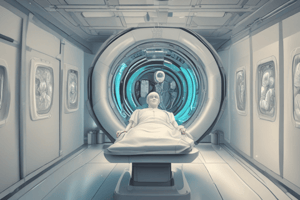Podcast
Questions and Answers
What contributes to the subject soft-tissue contrast in CT imaging?
What contributes to the subject soft-tissue contrast in CT imaging?
- Differences in beam energy
- Differences in physical density (correct)
- Differences in noise levels
- Differences in linear attenuation coefficient
Why can small differences in soft-tissue density be visualized on CT scans?
Why can small differences in soft-tissue density be visualized on CT scans?
- Due to the 2-dimensional nature of the image (correct)
- Due to the use of contrast media
- Due to high noise levels
- Due to the use of high beam energy
What is responsible for amplifying differences in grey levels (grey scale) for various tissues in CT scans?
What is responsible for amplifying differences in grey levels (grey scale) for various tissues in CT scans?
- Inherent tissue properties
- Beam kilovoltage
- Windowing (correct)
- Tube current
Why is imaging low-contrast objects with CT limited?
Why is imaging low-contrast objects with CT limited?
How does a higher tube current affect contrast in CT imaging?
How does a higher tube current affect contrast in CT imaging?
What factor influences the contrast resolution between adjacent objects imaged with CT?
What factor influences the contrast resolution between adjacent objects imaged with CT?
What does CT image quality depend on?
What does CT image quality depend on?
Which factor helps determine the sensitivity of a diagnostic CT image?
Which factor helps determine the sensitivity of a diagnostic CT image?
What is contrast resolution in CT imaging defined as?
What is contrast resolution in CT imaging defined as?
Which type of contrast impacts display contrast in CT imaging?
Which type of contrast impacts display contrast in CT imaging?
What determines CT subject contrast?
What determines CT subject contrast?
Which type of radiological events are most common in CT due to the high peak kilovoltage used?
Which type of radiological events are most common in CT due to the high peak kilovoltage used?
Flashcards are hidden until you start studying




